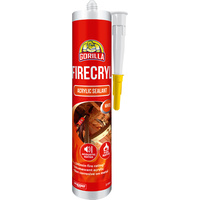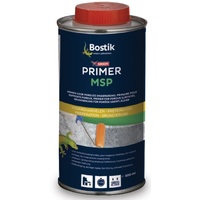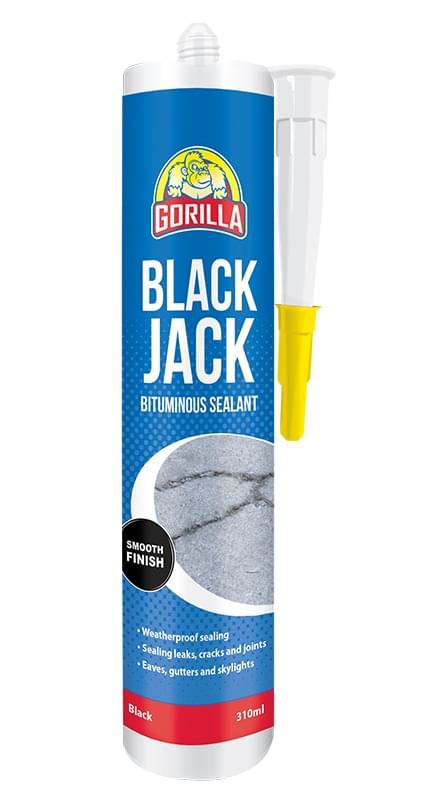Gorilla Blackjack Bituminous Joint Sealant
Posted : admin On 4/7/2022Tough, clear, 100% silicone sealant. Gorilla sealant is great for kitchen, bath, window, doors, auto, marine Plumbing, gutters and more! Ready for water exposure in just 30 minutes, this waterproof sealant is mold & mildew resistant. The clear silicone sealant and won't yellow, shrink or crack over time! The POURTHANE joint sealant line is designed for sealing concrete and metal joints in a variety of applications, including sidewalks, balconies, pavement, terraces, warehouses, factories, civil structures, plazas, and pitch pans. HOLDFAST® BLACKJACK® BITUMOUS JOINT SEALANT DATA SHEET Product Code: 19926 (310ml black cartridge) Product Name: BlackJack® Bitumous Joint Sealant Description BlackJackl® Bitumous Joint Sealant is a one component sealant based on bitumen and rubber. BlackJack® Bitumous Joint Sealant cures to a plastic.
- Gorilla Blackjack Bituminous Joint Sealant Home Depot
- Gorilla Blackjack Bituminous Joint Sealant Sealer
What is bitumen rubber mastic joint sealant?
Bitumen rubber mastic sealant is a single component and cold apply solvent based bitumen rubber mastic joint sealant. The sealant on curing forms a tough and flexible seal. it has excellent adhesion to concrete, brickwork, asphalt and most construction material substrates. The mastic sealant is modified with non-asbestos fibers to make the sealant thixotropic and slump free when applied on vertical areas.
Crack Filler , Crack Repair , Asphalt Crack Filler , Crack Sealant
Crack sealant is general term for materials which are used to fill and thereby seal cracks and joints in asphalt and cement pavement surfaces. Crack repair materials are sometimes also referred to in the art by terms such as, for example: hot pour; crack seal; crack sealer; crack sealant; crack fill; crack filler; joint seal; joint sealer; joint sealant; joint fill; joint filler; cold joint adhesives; marker adhesives; and other asphalt/resin/polymer compositions. Throughout the present specification and in the appended claims, the term “crack sealant” will be used exclusively, but the term should be understood to encompass all materials having the same general composition, use and/or properties. Asphalt Crack filler is widely used to fill and thereby seal cracks and joints in highways, streets, parking lots and driveways from water penetration. The use of crack sealants prolongs the service life of such pavement surfaces.
Application of bitumen rubber mastic joint sealant:
Flexible joint sealant
Stability at high ambient temperatures
Excellent adhesion, strong durable bond
Single component
Where you can use the bitumen rubber mastic joint sealant?
Bitumen rubber mastic joint sealant is ideally suited for sealing and filling gaps and joints on roofs, pointing horizontal chases for waterproofing membranes and felts. Sealing around roof/ wet service pipes. Pointing between brickwork and roof flashings. Sealing cracks in asphalt and concrete pavements. Filling horizontal joints in concrete and asphalt where movements are not expected.
How to use bitumen rubber mastic joint sealant?
Surface preparation
Surface must be free from all dirt, dust and loose material. Any oil and grease contamination must be removed completely. The surface must be made dry prior to the application of the sealant.
Masking
Prior to application of primer and sealant, apply masking tape to the adjacent sides of the joints for getting a neat finish and to avoid the spilling over of the sealant on the edges.
Priming
Under normal circumstances priming is not required. However, for very dry and porous surfaces, it is recommended to apply one coat of a solvent based bitumen primer. Similarly for joints subjected to continuous immersion, priming is recommended.
Application
The bitumen rubber mastic joint sealant can be applied by means of a spatula or trowel. As the product is solvented, it is recommended to mix the contents of the pail with a paddle mixer for a few minutes prior to the application to ensure a homogenous mix. Sealant application should start form the bottom of the joint/groove and continued to the top. Immediately tool the joint with the spatula or putty knife to smoothen and compress the sealant to effect total contact with joint surfaces. The putty knife shall be moistened with a cleaning solvent to prevent the sealant to adhere to the knife and ensuring a smooth and neat finish. Where masking tape has been employed to keep building surfaces clean, it is advisable to remove them at the moment the sealant filling is completed.

Hot bitumen poured crack filler sealant
Hot Crack Filler is a single component, hot-applied, rubberized asphalt crack and joint sealant. Hot Crack Filler is specially formulated for both direct fire and oil-jacketed melters. It is heat stabilized to withstand temperatures up to 450ºF without experiencing polymer degradation. When melted and properly applied it forms a resilient crack sealant for both asphaltic and cementations pavements.
Curing time of bitumen rubber mastic joint sealant
The sealant cures on solvent release. The initial surface skinning will occur within 24-48 hour, however full cure depends on relative humidity. A10mm depth of seal will typically cure within 14-21 days @23°C @50% rH.
Specification of bitumen rubber mastic sealant
Properties | Values |
Color | Black |
Form | paste |
Solids content, [%] | >80 |
Slump | Nil |
Density, [g/cc] | 1.1 ± 0.05 |
mAF, [%] | ±10 |
initial set @ standard condition [hrs] | 24 -48 |
Full cure @ standard condition [days] | 14-21 days (10mm) |
Chemical resistance | Sea water, chlorides and sulphate ions. |
Service temperature, [°C] | 0 to 80 |
Application temperature,[°C] | 5 to 45 |
Cleaning
Tools and equipment should be cleaned immediately after use with a cleaning solvent. Hardened materials can be cleaned mechanically only
Storage & shelf life
The pails and drums must be stored in a covered, dry and shaded area, away from direct sunlight, UV and other sources of heat and protected from extreme temperatures. The shelf life of the bitumen rubber mastic joint sealant is up to 12 months if stored as per the recommendations. Excessive exposure to sunlight and UV will result in the deterioration of the quality of the product and reduce its shelf life.
MSDS of bitumen rubber mastic joint sealant
Bitumen rubber mastic sealant contains petroleum distillate, is flammable. Keep away from fire, sparks or other source of ignition. Wear protective clothing, rubber gloves, and mask and safety goggles.
1. Fire – Flammable when wet.
2. Skin – Avoid repeated or prolonged contact. Remove bitumen stains with a suitable cleaner that is able to remove oil or grease and then clean with soap and water.
3. Eyes – Contact could cause irritation. Flush with copious amount of clean water.
4. Inhalation – can cause dizziness. if difficulty in breathing persists, administer oxygen.
Estimation
Theoretical Coverage: linear meter per kg of sealant


Joint Depth (mm) | 6 | 10 | 12 | 15 | 20 | 25 | 30 | 40 |
6 | 27.7 | 16.6 | 14 | 11 | 8.3 | 6.6 | ||
8 | 12.5 | 10.4 | 8.3 | 6.2 | 5 | 4.1 | ||
10 | 10 | 8.3 | 6.6 | 5 | 4 | 3.3 | 2.5 | |
12 | 6.9 | 5.5 | 4.1 | 3.3 | 2.7 | 2 | ||
15 | 4.4 | 3.3 | 2.6 | 2.2 | 1.6 | |||
20 | 2.5 | 2 | 1.6 | 1.3 |
How to produce bitumen rubber mastic joint sealant?
A process of producing bitumen rubber mastics sealant and sealants is as follows:
1. 4% to 11% treated Bentonite clay was to be added into clean water in the mixer. When clay is dispersed, or high sheared in colloid mill, after mixing it turns into clay slurry. The viscosity of clay slurry is between 20,000 to 180,000 centipoise (CPS) at 77 deg. F.
2. Asphalt bitumen cutback consists of 60 to 80 percent asphalt and 20 to 40 percent mineral spirit Stoddard solvent.
3. The clay slurry and asphalt bitumen cutback are mixed together to form a soluble system.
4. An additive is added to enhance the stability of the soluble system.
5. Non-asbestos fiber is added to reinforce the soluble system mastics and sealer film strength. It also provides additional viscosity and texture.
Included are cellulosic paper, fiberglass, mineral fiber, polymer fiber including polypropylene and polyethylene.
6. Non-reactive fillers commonly called pigment extenders are e.g. natural or calcined clay, mica and silica powder, slate powder, coal ash, fly ash, etc. are added to the system to improve film strength and product's consistency.
7. The elastomers impart buffering as well as tensile strength and elongation to the formulations and include SBR, SBS, SIBS, acrylic, styrene, neoprene, polyvinyl, etc.
EXAMPLE 1 The Preparation of Bituminous Rubber Mastic joint Sealant
% By weight | |
|---|---|
Treated Bentonite clay slurry | 3-60 |
Asphalt Bitumen Cutback | 20-90 |
Fibers | 2-10 |
Fillers | 3-15 |
Additives | 0.2-1.0 |
100.0 |
This formulation is used for patching repair, roof flashing repairs and installation.
EXAMPLE 2 The Preparation of Bituminous Rubber mastic joint Sealants
% By weight | |
|---|---|
Treated Bentonite clay slurry | 3-60 |
Asphalt Bitumen Cutback | 20-90 |
Fibers | 2-6 |
Fillers | 3-10 |
Additives | 0.2-1.0 |
100.0 |
This formulation is used for recoating by brush application on foundation walls, roof, metal, wood, concrete and other building materials.
EXAMPLE 3 The Preparation of Bituminous Non-fiber Sealants
% By weight | |
|---|---|
Treated Bentonite clay slurry | 3-60 |
Asphalt Bitumen Cutback | 20-90 |
Fillers | 3-10 |
Additives | .2-1.0 |
100.0 |
This formulation has similar uses as Example 2, except for spray application.
EXAMPLE 4 The Preparation of Elastomeric Bituminous Non-fiber Mastics
% By weight | |
|---|---|
Treated Bentonite clay slurry | 3-60 |
Asphalt Bitumen Cutback | 20-90 |
Fibers | 2-10 |
Fillers | 3-15 |
Additives | 0.2-1.0 |
Elastomers (Elastomeric polymers) | 0.5-5 |
100.0 |
This lends itself to both roofing and foundation application.
EXAMPLE 5 The Preparation of Elastomeric Bituminous Sealants
% By weight | |
|---|---|
Treated Bentonite clay slurry | 3-60 |
Asphalt Bitumen Cutback | 20-90 |
Fibers | 2-6 |
Fillers | 3-10 |
Additives | 0.2-1.0 |
Elastomers | 0.5-3 |
100.0 |

EXAMPLE 6 The Preparation of Elastomeric Non-fiber Sealant
% By weight | |
|---|---|
Treated bentonite clay slurry | 3-60 |
Asphalt Bitumen Cutback | 20-90 |
Fillers | 3-10 |
Additives | 0.2-1.0 |
Elastomers (Elastomeric polymers) | 0.5-6 |
100.0 |
Subject to the foregoing, the ranges and descriptions of components are about:
Gorilla Blackjack Bituminous Joint Sealant Home Depot
% By weight | |
|---|---|
Drilling mud bentonite | .5-11 |
Water | 3-55 |
Asphalt bitumen | 20-90 |
Cutback containing 60 to 80 wt. % asphalt and | |
20-40 wt. % mineral spirit Stoddard Solvent | |
Additives | .2-1 |
Non Asbestos fiber | 0-10 |
Fillers | 3-15 |
Elastomer | 0-8 |

Gorilla Blackjack Bituminous Joint Sealant Sealer
Of course, the individual amounts are selected to provide a 100% total.